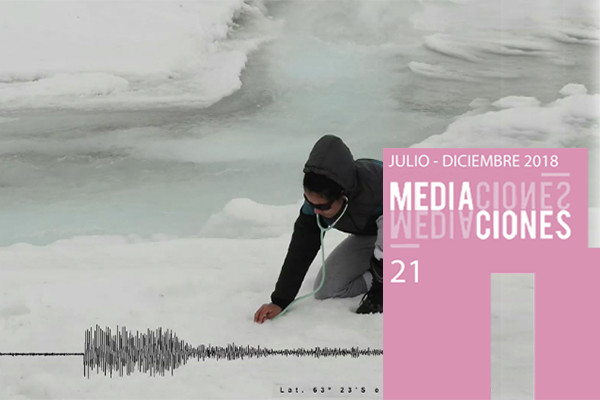Andean Female Representation in Peruvian Films from the Internal Armed Conflict
Article Sidebar

Downloads
How to Cite
Altmetrics
Article Details
![]()
Revista MEDIACIONES © 2024 by Corporación Universitaria Minuto de Dios - UNIMINUTO is licensed under the Creative Commons BY.
Main Article Content
Abstract
This paper focuses on the representation of Andean female characters (indigenous) in Peruvian films set in the Internal Armed Conflict (IAC 1980–1999) and their relationship with male characters from the coast and from the Peruvian Andes. Using the discourse analysismethod, the paper shows how this is an uneven power representation, where the female indigenous character is portrayed as the lowest step of the social-economic scale, with no agency or any self-power
to free herself from her own situation. This work analyzes La boca del lobo (1988), the first Peruvian film set during the iac, in which Andean women have a secondary role, stripping away from them any possibility of being empowered subjects. This way of portraying the Andean women answers to a patriarchal and racist structure, which not only shows Andean females as powerless, as subaltern subjects, victims of psychological and sexual violence, but also makes invisible the role that they had during the iac. Women’s role mainly consisted in confronting both the abuses performed by the terrorist groups and by the Peruvian armed forces. This powerless portrayal was maintained in other audiovisual Peruvian productions—as analyzed in my ongoing PhD research—and has established a vision of the Andean female as a diminished subject and also contributed to build the Andean people—mainly women—as the “other” in the iac. To understand how non-indigenous people of Lima have built an image of the main victims of the IAC may help rebuild this war-torn nation, since race and gender differences are still problems Peru must resolve.
References
Boesten, J. (2014). Sexual violence during war and peace. New York, NY: Palgrave Macmillan.
Burns, K. (2008). Desestabilizando la raza. En M. de la cadena (Ed.), Formaciones de indianidad. Articulaciones raciales, mestizaje y nación en América Latina (pp. 35–54). Bogotá: Envión.
Callirgos, J. C. (2015). El racismo en el Perú. En S. Oboler & J. C. Callirgos (Eds.), El racismo peruano (pp. 85–152). Lima: Ministerio de Cultura.
Comisión de la verdad y la reconciliación. (2004). Hatun willakuy. Lima: Idehpucp.
De la Cadena, M. (1992). Las mujeres son más indias. Revista Isis internacional, (16), 1-22.
Degregori, C. I. (2011). Qué difícil es ser Dios. Lima: Instituto de Estudios Peruanos.
Foucault, M. (1979). Microfísica del poder. Madrid: Ediciones de la Piqueta.
Gray, H. (2005). Cultural moves. Berkley, CA: University of California Press.
Grossberg, L. (2003). Identidad y estudios culturales ¿No hay nada más que eso? En S. Hall & P. Du Gay (Eds.) Cuestiones de identidad cultural (pp. 148–180). Buenos Aires: Amorrortu editores.
Hall, S. (2003). The work of representation. In S. Hall (Ed.), Representation. Cultural representations and signifying practices (pp. 1–74). London: The Open University.
Hall, S. (2010). Sin garantías. Trayectorias y problemáticas en estudios culturales. Popayán: Envión editores.
Jodelet, D. (2008). El movimiento de retorno al sujeto y el enfoque de las representaciones sociales. Cultura y representaciones sociales, (5), 32–63.
Lombardi, F. (1988). La boca del lobo. Perú: Inca Films
Moscovici, S. (1979). El psicoanálisis, su imagen y su público. Buenos Aires: Huemul.
Mulvey, L. (1989). Visual and other pleasures. New York, NY: Palgrave.
Rezende, L. A. (2013). Micro física de documentário. Rio de Janeiro, RJ: Beco de Azogue.
Rodríguez, T. (2002). Representar para actuar. Representar para pensar. Breves notas metodológicas. En C. Del Palacio Montiel (Ed.), Cultura, comunicación y política (pp. 25–40). Guadalajara: Universidad de Guadalajara.
Said, E. (2004). Cultura e imperialismo. Barcelona: Anagrama.
Said, E. (2013). Orientalismo (5th. Ed). Barcelona: Debolsillo.
Scott, J. (1996). El género: una categoría útil para el análisis histórico. En M. C. Cangiano & L. DuBois (Eds.), De mujer a género. Teoría, interpretación y práctica feminista en las ciencias sociales (pp. 17–50). Buenos Aires: Centro Editor de América Latina.
Spivak, G. C. (2003). ¿Puede hablar el subalterno? Revista Colombiana de Antropología, 39, 297–364.
Wade, P. (2008). Identidad racial y nacionalismo: una visión teórica de Latinoamérica. En M. De la Cadena (Ed.), Formaciones de indianidad. Articulaciones raciales, mestizaje y nación en América Latina (pp. 367–390). Bogotá: Envión.
Similar Articles
- Amparo Cadavid, Cicilia Krohling Peruzzo, Thomas Tufte, Reimagining Communication in World-Making , MEDIACIONES: Vol. 20 No. 33 (2024): July - December. COMMUNICATION AND SOCIAL CHANGE
- Matheus Rodrigo Serafim Rodrigues, Disco Elysium: Memories of the End of History , MEDIACIONES: Vol. 21 No. 34 (2025): January - June. COMMUNICATION AND POWER
- T. Hazeena, Wildlife in the backyard: contemplating on human-wildlife interactions by community radio in South India , MEDIACIONES: Vol. 20 No. 33 (2024): July - December. COMMUNICATION AND SOCIAL CHANGE
- María Cristina Caro, Evidences, Transformations and Displacements of the Body in Dystopian Societies: , MEDIACIONES: Vol. 19 No. 31 (2023): July - December. COMMUNICATION, GENDER AND SEXUAL DIVERSITY
- Isabel Vasen, An Intersectional Study of Audiences: Cisgender and Heterosexual Youth in Dating Apps , MEDIACIONES: Vol. 19 No. 31 (2023): July - December. COMMUNICATION, GENDER AND SEXUAL DIVERSITY
- Gabriela Santos Alves, Karolyne Gomes Mendes, Rosane Vasconcelos Zanotti, Women, Cities and Harassment: , MEDIACIONES: Vol. 19 No. 31 (2023): July - December. COMMUNICATION, GENDER AND SEXUAL DIVERSITY
- Patricia Posch, Rosa Cabecinhas, Images and (in)visibilities: , MEDIACIONES: Vol. 19 No. 30 (2023): January - June. COMMUNICATION AND MIGRATION
- Álvaro Maximiliano Pino Coviello, Elisabetta Gola, Communication technologies (TECOM) as tools generators of alternative work for a group of refugees and migrants in the city of Curitiba, Brazil , MEDIACIONES: Vol. 19 No. 30 (2023): January - June. COMMUNICATION AND MIGRATION
- Sidney Dupeyrat de Santana, Mohammed ElHajji, Do Pacífico ao Atlântico: , MEDIACIONES: Vol. 19 No. 30 (2023): January - June. COMMUNICATION AND MIGRATION
- Otávio Ávila, Borders between webdiaspora and the migrant self: five discursives typologies of communicational ecosystem , MEDIACIONES: Vol. 19 No. 30 (2023): January - June. COMMUNICATION AND MIGRATION
You may also start an advanced similarity search for this article.




